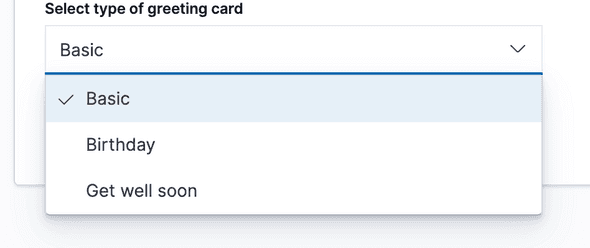The Basics of Kibana Pluggability Part Two
May 17, 2020
Goals
By the end of this post you should:
- Understand what a registry is and how to create one
- Understand when to use one
Brush up on the basics
Be sure to read The Basics of Kibana Pluggability Part 1 before reading this.
Why use a registry?
Back in part 1, I showed a simple example of a plugin that gave users the ability to create different types of greeting cards. These greeting cards types were hard coded. For every new type I wanted to add, I’d have to add an extra “if” statement. That is no good!
In this second iteration of the plugin, I built an internal registry of greeting card templates.
export interface GreetingCardPersonalization {
message: string;
to: string;
from: string;
}
export interface GreetingCardTemplate {
id: string;
displayName: string;
render: () => React.ReactType<GreetingCardPersonalization>;
}I add these items in the setup lifecycle of my plugin
public setup(core: CoreSetup) {
const { BirthdayGreetingCard } = await import('./templates');
return {
id: 'birthday',
displayName: 'Birthday',
render: () => BirthdayGreetingCard,
}
});
this.registerGreetingCardTemplate(async () => {
const { GetWellSoonGreetingCard } = await import('./templates');
return {
id: 'getWellSoon',
displayName: 'Get well soon',
render: () => GetWellSoonGreetingCard
}
});Now, if I want to add a new type of greeting card, I just have to add a new registry item, and it shows up automatically.
// greeting_card_creator.tsx
<EuiFormRow label="Select type of greeting card">
<EuiSuperSelect
onChange={e => setTemplateId(e)}
valueOfSelected={templateId}
options={templates.map(template => ({ value: template.id, inputDisplay: template.displayName }))}
/>
</EuiFormRow>// greeting_card_viewer.tsx
const Card = template.render();
return (
<EuiPageContent>
<Card to={to} message={message} from={from} />
</EuiPageContent>
);Another benefit of this abstraction layer, is that I can customize the rendering of each greeting card type.
Adding a new registry item
Now adding a new greeting card type is very simple, and I only have to touch one file:
// plugin.ts
this.registerGreetingCardTemplate(async () => {
return {
id: 'lame',
displayName: 'Basic',
render: () => ({ to, message, from }) => <div>{`Hi ${to}, ${message}, from ${from}`}</div>,
}
});And it shows up automatically!


Pitfalls and Limitations
So far, I haven’t exposed any extension points in my plugin. The only way to add new greeting card templates is to write code directly into my plugin. This is limiting. I only have so much time, and users of my now very popular greeting card application are clamouring for new greeting card types. Some of those users have very specific needs. I don’t want to be in the business of creating and maintaining hundreds of greeting card templates.
So what should I do?
Expose my first extension point!
What’s next?
Stay tuned for Part 3, and I’ll walk through creating your plugin’s first public API.
